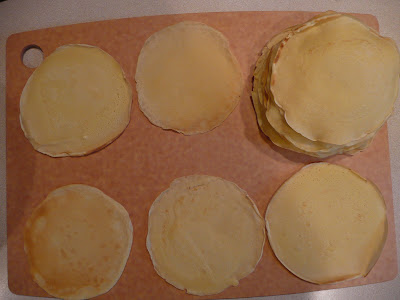Which means that spring is here, and the hyacinths are pushing the tips of their pretty green foliage through the garden soil, and the threat of snow is (mostly) over, and the barn is warm enough that I can switch from my fleecy winter breeches to my regular ones when I ride.
The end of March also occasions the end of yet another year of Nephew-Birthday-Cake-Making. And I'm not going to lie to you: while I love to make cakes for my little nephews' parties, I love being done with it even more. Because my nephews have taken to "challenging" me (their word) with their cake requests, and birthday-cake-making has come to consume entire weekends. I feel a slight weight off my shoulders now that the birthdays are over: the parties have been celebrated, the cakes have been eaten and enjoyed. Though I know the respite is brief, as Dad guffawed loudly when I stated that my birthday cake days were over for 2009. "A-HEM. My birthday is in May."
So I guess I'm not done.
At any rate, I thought I would share this year's creations with you all. First, Younger Nephew, who turned four in February, requested a cake of King Boo riding the Piranha Prowler. Many of you most likely know (as I did not) that King Boo is a Super Mario Bros. character, and the Piranha Prowler is one of the cars you can choose in Mario Kart Wii. Younger Nephew said, "I want to challenge you, Aunt Di." At first I thought he just wanted King Boo. Easy enough, considering that he's pretty much a white sphere with teeth. But then he clarified that King Boo must be riding the Piranha Prowler, just like he does when Younger Nephew plays Wii.
Thankfully, the Piranha Prowler resembles a VW bug, and I have a VW bug-shaped cake pan. So what Younger Nephew deemed extremely "challenging" turned out to be much easier than I expected. The tongue is 10 layers of fruit roll-ups and the crown is a tuile cookie. (Many thanks to the Daring Bakers, whose January challenge was tuiles!) The real trick with the King Boo cake was getting it safely to the Chuck E. Cheese about 15 miles across town. I kept fearing the King Boo part was going to crush the Piranha Prowler part, but: thank goodness for skewers. The cake-maker's best friend.
Younger Nephew, for his part, thanked me by biting off the tongue and, after the party was over, licking the icing off King Boo's eyes. I think that means he liked it.
Now, Older Nephew, who turned seven about a week ago, originally requested a cake in the shape of Bullet Bill, another Mario Kart entity. I was agonizing over how to make the arms when...Older Nephew decided he wanted a Hot Wheels cake instead. Bless your heart, Older Nephew.
The Hot Wheels cake was pretty simple as well, just a 13" x 9" two-layer cake "carved" to resemble the shape of a car. I baked the wheels in my three- and four-inch cake pans, then cut out an area from the body of the car in which to nestle them. I attempted to make that large silver area (I have no idea what to call it, as it does not correspond to a part of any car I've ever seen) out of fondant, but fondant once again reminded me why I don't really like it. In addition to the fact that I don't think it tastes very good, I have difficulty getting it to stick to itself. And I'm never happy with the way it looks. Too smooth, sculpted and perfect. I think a cake should look like a cake. So I piped the area in gray icing and sprinkled it with Wilton's "cake glitter." (Though I did have to reassure one party-goer's mother that the glitter was indeed edible.) I knew the cake was a success when one of Older Nephew's friends ran over to it and exclaimed, "It's a Hot Wheels cake!"
Older Nephew was very excited at his party, which Sister held at a place that has laser-tag and "Euro Bungy," which is just as awesome as it sounds. So Older Nephew was a little too preoccupied to be bowled over by his cake. But in the car on the way home -- in between the constant laser-tag chattering -- he did thank me for his cake, in the sweetest way possible.
I know that Nephews will soon be too old to want a cake from their aunt. So I do cherish these days.
Even if I am exhausted and totally out of piping bags.











































